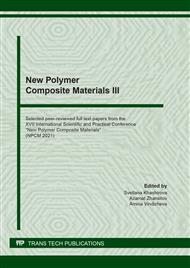p.660
p.675
p.681
p.688
p.694
p.701
p.709
p.715
p.720
Physical and Chemical Fundamentals of Building the Structure of Dispersed Filled Polymer Composite Materials and Nanocomposites
Abstract:
Questions of the construction of dispersed structures of polymer composite materials using a generalized model of dispersed filled polymer composite materials (DFPCM) are studied. Using the parameter of maximum proportion of filler (φm) allows you to take into account the size, shape, and distribution of part of the dispersed filler at the same time. The transition to generalized and specified parameters when describing the structure of the DFPCM leads to the possibility of highlighting the optimal criteria for obtaining systems with the highest strength characteristics. The transition to generalized and reduced parameters when describing the structure of DFPCM leads to the possibility of selecting optimal criteria that ensure obtaining systems with the necessary level of rheological, electrochemical, physico-mechanical and other characteristics.
Info:
Periodical:
Pages:
694-700
Citation:
Online since:
September 2021
Authors:
Price:
Сopyright:
© 2021 Trans Tech Publications Ltd. All Rights Reserved
Share:
Citation:


